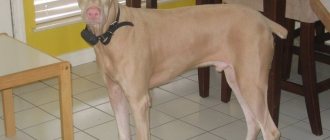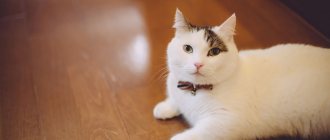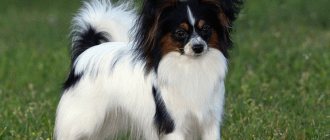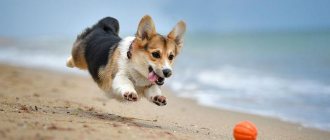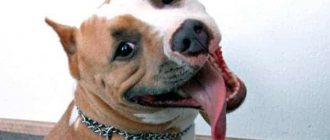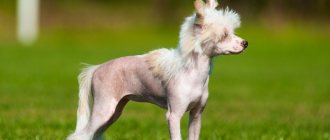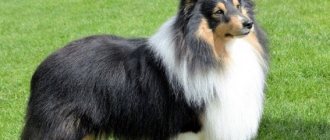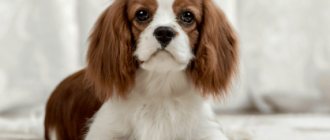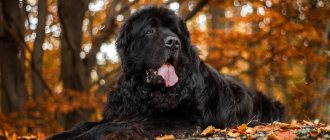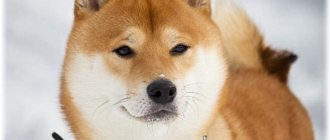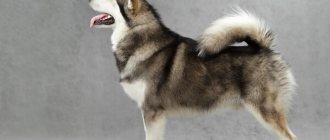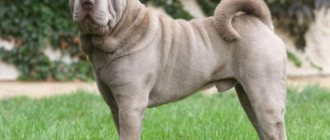The Alaskan Malamute is highly prized in the north. In northern latitudes it is used as a sled dog. An adult Alaskan Malamute dog is distinguished by sociability, endurance, large size, ability to work and a strong character, which is incredibly combined with friendliness.
Representatives of the oldest breed, walking with their owner, become the center of attention and arouse the admiration of others. They are often confused with cheerful and cheerful huskies. However, there is still a difference between the Alaskan Malamute and the Husky.
The main features of these wonderful dogs are strong limbs and great drafting ability. But it is their pretty appearance that makes Malamutes everyone’s favorite.
History of the Alaskan Malamute breed
The Alaskan Malamute is the oldest breed in North America. At the same time, it is considered one of the oldest on the planet. It is possible that the Alaskan Malamute, in comparison with other dogs, lives the longest next to humans. This theory is supported by archaeological finds, which confirm that Malamutes have remained virtually unchanged genetically since ancient times. In 2004, experts analyzed their DNA and concluded that it has a strong genetic similarity to the wolf. It is highly likely that the ancestors of modern Malamutes are domesticated wolves. The latter were immigrants from Central and East Asia, arriving in North America through the Bering Strait along with their nomadic hosts. This happened about 14 thousand years ago.
Alaskan Malamute
Interesting results were also obtained as a result of analysis and comparison of the DNA of the Alaskan Malamute, Alaskan Klee Kai and Siberian Huskies. It turned out that they are related not only to the wolf, but also to each other. The only differences were found in size and weight. Alaskan Malamutes are larger than their counterparts and have heavy bones and a powerful build. Weight ranges from 34-39 kg, while, for example, Siberian Huskies weigh 20-27 kg.
Alaskan Malamutes did not immediately become sled dogs. In those ancient times, Eskimo tribes led a nomadic lifestyle, moving through areas with harsh weather conditions in search of food. Dogs were full members of the tribe, performing guard functions and helping men on the hunt. It was the cold climate of Alaska, coupled with limited food resources, that played a fundamental role in the development of this breed. Weak individuals who found it difficult to survive simply fell out of the genetic chain as unnecessary links. The strongest and fittest survived. The breed developed over the centuries in the Anvik River basin, where representatives of the Malemute Eskimo tribe settled from Siberia to Alaska.
The Eskimos developed Malamutes according to their own simple standards, which had nothing to do with beauty. The main thing is that the dog is a faithful assistant - strong, capable of hunting, pulling sleds and adapted to bitter frosts. Natural selection work yielded results, and the Alaskan Malamute became what we know it today.
The breed also gained popularity among Europeans. This happened towards the end of the 19th century, although their acquaintance with it began from the time of the conquest of Siberia. Why then, and not earlier, you ask? The fact is that in 1896, a gold rush began in the Klondike, and crowds of people wanting to get rich poured there. They were interested in quickly moving around the area. And since in the conditions of the North this is not an easy task, malamutes came in handy. The popularity of dogs of this breed has caused their prices to soar. For one individual they asked for 500 dollars, and for a whole team - one and a half thousand. In modern equivalent, this is 13 thousand and 40 thousand dollars. Thus, Malamutes became the most sought-after and most expensive dogs in northern latitudes.
Gold miners also brought with them representatives of other breeds, for example, Newfoundlands and St. Bernards. By crossing them with Malamutes, prospectors hoped to get stronger and more resilient dogs. However, such mestizos did not live up to expectations as sled dogs. Instead of pulling the sleds, they snapped and fought with each other. At the same time, the sport of sled dog racing was popularized. The 408-mile All Alaska Sweepstakes race, held in 1908, made history. Dogs were collected from all over Alaska to participate, since winning it meant not only fame and prestige, but also money.
Malamute puppies
The undeniable quality of Alaskan Malamutes is endurance. Only in terms of adaptation to the climate, ability to work in a team and speed qualities, this breed was inferior to dogs of other species. The owners hoped to improve these indicators in her by crossing with representatives of small breeds. Such efforts have brought purebred dogs to the brink of extinction. The situation especially worsened in 1920, when the number of the latter dropped to a critical level. To prevent the breed from becoming extinct, a small group of enthusiastic breeders joined forces and restored it.
Over the next two decades, the breed was divided into three lines - M'Loot, Kotzebue and Hinvan-Irvine. Their representatives are the ancestors of modern Malamutes, retaining the features of one or another line. But the white streak in the development of the breed did not last long - the Second World War began. Four-legged representatives of Alaska took part in it and suffered huge losses. By 1947, the Malamute population had reached a critical point: only 30 registered individuals remained. To preserve the breed, breeders had to make some sacrifices, namely, deviate from the line standards.
In the 21st century, the Alaskan Malamute has not only survived, but also continues to be one of the most popular dog breeds. Its history began simply as a sled dog, and today it is the official symbol of the largest and northernmost American state - Alaska. However, this status does not at all prevent these very efficient and hardy dogs from fulfilling their traditional role - transporting heavy loads.
Features of the Alaskan Malamute
Psst, do I look like a wolf?
The Alaskan Malamute is a large, beautiful and strong dog that looks like a wolf. The spectacular appearance, which invariably attracts attention, is complemented by irrepressible energy, which only experienced lovers of this breed, who have a keen sense of the psychology of their pets, can cope with. These northern giants treat people kindly, but strive to dominate them. In everyday life, this character trait is not considered positive, but in extreme situations it is a big plus. There are cases when, thanks to the ability to make independent decisions, a dog saved the life of its owners.
For Russia, this breed has long been exotic and represented in small numbers. However, recently in our country she has been gaining more and more fans. Many, however, are subsequently disappointed in their dog. But this is not the fault of the malamute: such a dog does not need to be acquired spontaneously, but first you should collect all the information about the characteristics of character, behavior and living conditions. The choice in favor of this breed should not only be conscious, but also carefully weighed.
To what age do they grow?
Like puppies of other large breeds, Malamutes are characterized by rapid rates of development . Their skeleton develops especially quickly during the first months of life and by 7-8 months the puppy acquires the size of an adult dog.
The formation of the musculoskeletal system ends by the age of 1, but the dog’s development continues - its figure is formed, its chest is enlarged, muscle mass is built up.
This process can last for several years and depends on the quality of nutrition, regularity, quantity and activity of walks and a number of other factors.
Appearance and special features of the breed
The main “mission” of the northern handsome man is the same as that of the husky – to drag loaded sleds through the snow. The Malamute has a lot in common with the Husky: both dogs have a wayward character, many even confuse these breeds. But the differences between them are not so difficult to find. The Malamute is taller, weighs more, and has a wider bone than a husky. All these qualities make the handsome Alaskan much tougher than his closest brother: with a heavy harness he can run for a whole day. Representatives of these breeds also have different coats; in Malamutes it is longer and thicker. But the color is almost identical.
Heterochromia in the Alaskan Malamute
general description
The Alaskan Malamute, one of the top 30 most popular breeds in North America, belongs to the Spitz group. This is a strongly built dog with a muscular body, densely covered with thick hair. Representatives of the breed are also distinguished by a large head and deep chest. The height at the withers and weight of males and females are different: 63.5 and 58.5 centimeters and 38 and 34 kg, respectively. Looking at the puppies, it’s even hard to believe that they grow into huge and energetic dogs. Malamutes in childhood are plush hulks that evoke affection.
High five!
The depth of the northern heavyweight's chest is equal to half its height at the withers, but its lowest point is located behind the forelimbs. If you measure the body from the shoulder-scapular joints to the ischial tuberosities, it turns out that its length is greater than the height at the withers. The power and temperament of adult male dogs can amaze even the most experienced dog lovers. This will surprise you, but Malamutes can be kept in a city apartment. But to prevent him from acting like a bull in a china shop in your home, teach him various commands and don’t let him dominate. The enormous stubbornness and self-will of these dogs must and can be fought. With a positive result of your efforts, you will receive a faithful friend for many years.
Despite their impressive appearance and some character flaws, Alaskan Malamutes sincerely become attached to their owners, love them, and show devotion. They are friendly, playful and kind. The movements of a dog of this breed are smooth, fast and balanced. The push that the hind limbs give is transmitted, like electricity through wires, to the forelimbs through the developed lower back. If you look from the side, the moment of the push is very clearly visible. The forelimbs, in turn, take a wide and smooth step. The legs moving along the line - this is clearly visible when viewed from both the front and the back - do not step too wide, but not too narrow. As the pace accelerates, the paws become close to the center line. Experts recommend that if your pet steps or generally moves in a way that interferes with productivity and efficiency, punish him to avoid repeating similar mistakes in the future.
Head
It is not too heavy, but deep and wide. It looks proportional relative to the body. The skull is also wide, moderately rounded between the ears, with gradual flattening and narrowing towards the eyes, and also rounded into the cheekbones. The Malamute's muzzle is large relative to the skull. Its upper line is slightly lowered and thereby diverges slightly from the upper line of the skull. The groove between the eyes is weakly expressed. The transition from the forehead to the muzzle (the so-called stop) is not sharp, but noticeable. From the stop to the nose, the muzzle decreases slightly - both in width and depth.
Alaskan Malamute muzzle
Teeth
Large, with a regular scissor bite. The jaws are wide and powerful, the cheekbones are flat. An overshot or undershot qualifies as a defect.
Eyes
The Malamute's eyes are almond-shaped and medium in size. Placed obliquely, color – brown. The presence of blue eyes in a representative of the breed is not just a defect - it is a disqualifying defect.
Ears
Fluffy puppy
Triangular in shape, medium size, rounded at the ends. The heads look small in comparison. Located on the back of the skull, along its outer edges. Are in line with the upper corners of the eyes. You can judge the dog’s mood by the direction of the ears: if they “look” to the sides, it means that something has alerted your pet. When a Malamute is at work, that is, carrying a load, its ears are often laid back. In a vertical position (erect), the ears point slightly forward. High set ears are considered a defect.
Nose and lips
The Malamute has a large nose and wide nostrils. The nose is black, as are the lips and eye rims. This standard is required for Malamutes of all colors. The exception is red dogs: they are allowed a brown nose. Weak pigmentation of the nose is possible during the cold season; it is called “winter nose.” The lips are thin and fit tightly.
Neck
Strong, powerful, moderate curvature.
Frame
It is not particularly massive, but the bones are strong. Not short, looks compact.
Tail
The tail of the Alaskan Malamute is densely covered with thick hair, raised above the back, but does not touch the back and does not curl onto it. At the base it continues the line of the middle position (that is, the top).
Limbs
The forelimbs of the Malamute are distinguished by well-developed muscles and massive bones. They are straight up to the pasterns, spaced parallel. The shoulder blades have a slight slope. The pasterns are strong but short and, when viewed from the side, appear somewhat slanted. The paws are of the “snowshoe” type; they are large, deep and collected, with well-developed pads. The toes are closed tightly, well curved, with protective fur between them. The claws are strong.
The hind limbs are also massive and strong. If you look from behind, you can see that they are in line with the front ones. The setting is “medium”, that is, not too wide and not too narrow. The thighs are very muscular, the knees are moderately angular. The hock joints are located low to the ground and slightly pronounced. The toes have short claws, are well curved and tightly closed, with fur growing between them. The pillows are durable and thick. The presence of dewclaws is undesirable; they are usually removed from puppies immediately after birth.
Wool
Malamute
The Alaskan Malamute has a double coat, consisting of two types of hair that differ in texture. The first is a protective cover: its hair is hard, guard hair. The second is the undercoat, it is soft and dense. The length of the outer coat and undercoat varies on different parts of the body.
The body hair, when viewed along the sides, varies in length - from short to medium. The hair is longer on the neck, shoulders, rump, hips, tail and down the back. During the warm season, the Malamute's coat is shorter and not as thick. Representatives of this breed do not have their hair cut or trimmed.
Color
The most common color in Malamutes is the so-called wolf color. Black, grey, white and sable colors are also acceptable. The combination of several colors is not prohibited, but only on the undercoat or in the “pants” area. Mixing colors in other areas is unacceptable; it is considered a vice.
White color invariably dominates the lower part of the body, partly on the limbs, paws, and also in the form of a mask on the face. A white mark on the forehead and a spot or collar of the same shade in the back of the neck are acceptable - it looks very attractive!
It is important to know: the color of Alaskan Malamutes is coated, which eliminates the presence of unevenly located spots or even breaking the color.
Possible defects
Limbs and paws are the “tools” of Alaskan Malamutes. Any pathology - regardless of whether it occurs on the front or hind limbs, whether it manifests itself in movement or in a standing position - is classified as a serious defect. Accordingly, the cow's rear legs, straight shoulders, markings, weakened pasterns, and poor angles will also be considered defects. Serious deficiencies include, among other things, stilted movements or any other types of movements that are assessed as insufficiently productive or downright unstable.
Experts consider the dog’s generally poor proportions, heaviness, slenderness, and not very strong bones to be the possible defects of the breed. Any deficiencies and defects and their severity are assessed in proportion to their severity and impact on the welfare of the animal and its daily health.
Disqualifying faults
Blue eyes and other obvious physical abnormalities are considered disqualifying. Among mental disorders, cowardly or, conversely, aggressive behavior leads to disqualification.
The testes of male dogs, there are two of them, should be normally developed and completely descended into the scrotum.
Photo of an adult Alaskan Malamute
Malamute character
Dogs of this breed cannot be considered lazy and lazy.
They are highly motivated to work, have irrepressible energy, requiring almost constant attention. Some owners initially expect that after a walk in the fresh air the dog will get tired and want to sleep. But no. Returning home, he begins to rush around the apartment, “fight” with the furniture and spoil things. Living in a private house does not solve the problem of overly active behavior of a Malamute. When you let him out into the yard, be prepared for him to dig a huge pit.
Alaskan Malamutes in harness
Some owners call Malamutes a great way to lose weight without dieting. As a joke, of course. But there is some truth in this statement. From an early age until the age of three, these Alaska natives display particularly remarkable energy. And in order to somehow curb it, direct it in a controlled direction, the owner is forced, whether he wants it or not, to constantly play with his pet, exercise intensively with him and be ready for long runs. The dog will settle down and become calmer only after 3 years.
The Alaskan Malamute is similar in appearance to a wolf, which prompted many to raise it as a hunter or guard dog. Almost nothing came of this venture; the defender's traits in his character are poorly developed. In addition, Malamutes cannot bark, but they sing excellently. There’s just one problem: if a thief has broken into the apartment, you can’t tell by the dog’s singing. If there had been barking, that would be a different matter.
Innate good nature and sociability will not prevail in the dog’s character if there is improper upbringing and lack of training. In this situation, she becomes dangerous and uncontrollable, strives to dominate the household, so you should not neglect the proper upbringing of an Alaskan native. He needs to constantly prove that he is not the boss in the house, but you! Otherwise you won't have any problems.
Nature has endowed the Alaskan Malamute with excellent memory. In the conditions of the North, it turned out to be very useful, since the dog needed to somehow return home through the snow cover. In our climate, such ability to navigate is not needed, but memory has not gone away and should be taken into account. When training your dog, be gentle with it, without being rude. Malamutes remember bad treatment very well and, on occasion, will remember it to you, and may even take revenge.
Malamutes have fun in a rather unique way. When they get bored with the everyday routine, they begin to rush around the apartment, house or yard, demolishing everything that gets in their way. Broken pots and torn pillows are nothing. It can happen even worse: a dog can chew furniture and tear off wallpaper, after which you have to spend money on new repairs. Representatives of this breed, like huskies, do not like confined spaces. Their element is will, so it is better and cheaper to keep your North American pet in a large and spacious enclosure, with regular walks in the open air.
Small children or small animals should not be left alone in the house with the dog. He is large and loves to dominate, and one careless move will be enough to injure those who are weaker than him. It is very funny to watch how Malamutes and their close cousins, Huskies, show their acting abilities by “imagining” themselves as cats. They lie down with their paws tucked like a cat and hunt in the same way - first they hide, and then they jump up sharply.
Training and education
Malamutes are very smart and agile, and these qualities appear almost from birth. A puppy of this breed begins to strive for leadership early. In his upbringing, one must show firmness and consistency, constantly give feasible physical activity, which should be increased as he grows older. You can start training immediately after purchasing a puppy, teaching him how to call, simple commands and, what is also important, how to be neat.
Steel endurance
It is important to know: innate good nature does not prevent dogs of this breed from being aggressive towards other dogs or chasing cats or birds.
Socialization of a Malamute is an important stage in his life. You can start visiting the training site from the age of 4 months, when the vaccination quarantine ends. In addition to teaching discipline, a Malamute puppy, communicating with other dogs, will certainly find friends for noisy games. At the same time, you should accustom your pet to extraneous sounds, passing cars and other irritants. Thus, you will strengthen his nervous system and make the dog’s living in the city comfortable. Many owners who plan to place a dog in a country house sometimes neglect these simple rules. As a result, the dog's socialization suffers; it feels uncomfortable on noisy city streets.
What to feed for the first 3 months?
During the first 2-3 weeks, the puppy's food consists only of mother's milk. If for some reason this is not possible, you should purchase a substitute (for example, Royal Canin Babydog Milk) or use baby food without lactose and sugar.
When the puppy is approximately 20 days old, complementary foods in the form of calcined cottage cheese and goat's milk should be introduced into its diet..
Once the puppy reaches 1 month, the amount of complementary foods must be increased. Malamute can be given dry food pre-soaked in water, whole milk, calcined cottage cheese, boiled yolk, boiled minced beef, and low-fat broth.
At 2 months, when the puppies already have milk teeth, you can give scraped frozen meat, vegetables, fruits, herbs, dairy products, cereals, eggs.
After 2 months, whole milk should be excluded from the diet.
At 3 months old, Malamutes can eat all foods included in the list of foods allowed for this breed. All new foods should still be introduced into the diet gradually, observing the pet's reaction.
Care and maintenance
This is Love!
One of the distinguishing features of the Alaskan Malamute is its thick coat. This “fur coat” allows you to keep dogs outdoors all year round; they are not afraid of frost. The coat thins significantly only in summer. Regardless of the season, the Malamute's coat needs to be looked after, especially during the molting period.
The Malamute, despite its size, is an athletic dog and therefore needs many hours of jogging. Constant physical activity allows them to train not only their muscles, but also their minds. Keeping a representative of this breed in the courtyard of a private house does not relieve the owner of the need to walk with his pet. These dogs abhor idleness; they begin to get bored and howl with anguish, destroy everything they come across, or begin to “entertain” themselves by digging huge holes.
Alaskan Malamutes are unpretentious in nutrition; they can be fed natural food. Usually, owners cook a mixture of cereals in broth for them, adding pieces of beef tripe or trimmings to the porridge. You can give your dog ready-made dry food, but its quality must be high enough. Ready-made food with a high protein content is especially necessary during preparation for exhibitions and races. There is no need to worry about your dog getting better. Due to his natural mobility, he is not at risk of obesity.
Crossbreed
When these breeds are crossed, wonderful creatures are obtained: Haskomuts or Aluskys (Aluskys)
